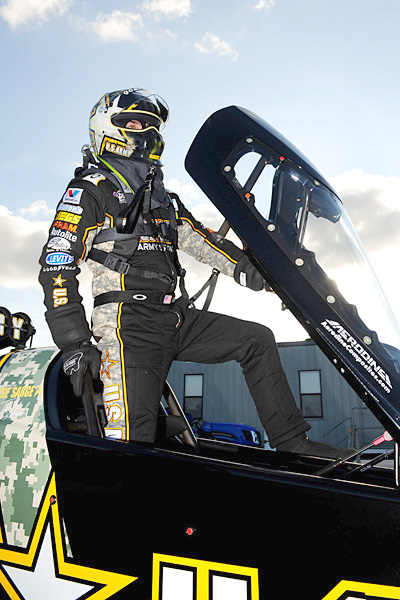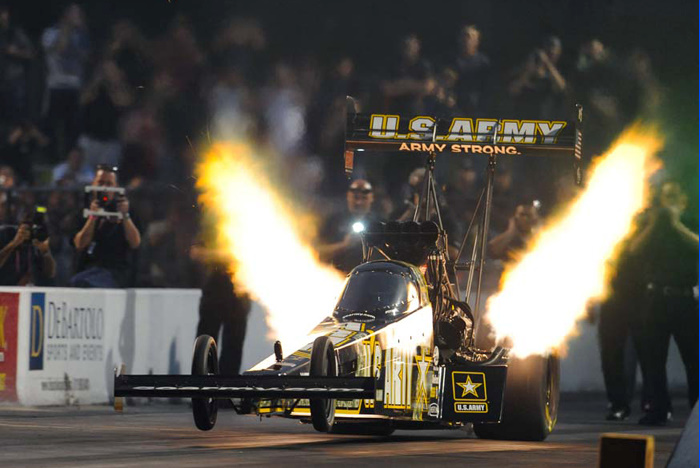Schumacher says Wheldon would have been safer with Canopy
 |
| Schumacher says Dan Wheldon would have been safer if IndyCar's had canopies, something AR1.com recommended after Wheldon was killed. Like NASCAR (Who had to lose both Adam Petty and Dale Earnhardt before they approved the HANS Device), IndyCar will have to lose another star before it takes any action. |
| Mark Rebilas/USPresswire |
The NHRA plans to use an independent group, possibly Purdue University, to test the aerodynamics of the canopy. NHRA Safety Safari officials will look at the enclosure this weekend at Pomona to make sure it can be easily opened to extract a driver in case of a fire.
Tony Schumacher said all those scenarios, including air pressure in the canopy, have been considered. The enclosure actually is a section of the car's body sheet that fits over the driver compartment. The canopy, which is made of Kevlar and carbon fiber, can be opened from inside or outside.
Schumacher actually approaches the starting line with the canopy open. It is closed before staging.
Schumacher also believes that this type of canopy should be considered by the IndyCar Series in response to Dan Wheldon's death in October at Las Vegas.
"Would Wheldon have been safer with it? I would bet by far, yes,'' Schumacher said. "But it's a bet.
“The fact is I feel safer under it. When I sit in this car with the canopy, I have a level of comfort that I haven't had in a long time. Every driver should have that feeling. I've lost some good friends out here and don't want to lose any more."
"Unless we throw it out of an airplane and see what happens, we're not going to know until someone is upside down. You can't fake-crash it. You can't throw it out of a truck at 300 miles per hour. There are certain things you can't test until something happens."
 |
| When it comes to the safety of an enclosed canopy, NHRA gets it, IndyCar does not |
02/01/12 Don Schumacher Racing's (DSR) innovative fully closed canopy Top Fuel car is ready for action – but hasn't passed all the strictures by the National Hot Rod Association (NHRA) for use in Full Throttle Drag Racing Series competition.
"We have to go through the proper channels with NHRA to get approval for the canopy," team owner Don Schumacher said, "and NHRA wants to take a close look at it. We'll take it to Pomona where officials, the Safety Safari and other drivers and owners can get a close look at it."
The canopy fits within an existing dragster chassis. Schumacher doesn't intend to race it at the opening stanza next weekend at Pomona nor the following weekend at Phoenix.
Driver (and son) Tony Schumacher is an adamant supporter of the canopy despite the additional 25 pounds of ballast it adds to his car's weight. His best run with the canopy in place was 3.751 seconds at 324.28 mph, set during the January 15-21 testing at Palm Beach International Raceway in Jupiter, FL. He made 13 passes down the 1000-foot dragstrip with the canopy; teammate Antron Brown also made a run to test this new equipment.
"This isn't about performance; this is about safety," Tony Schumacher said. The seven-time NHRA Top Fuel champion continued, "I want every driver to have one. We aren't hiding anything. Again, this is just all about making it safer for all the guys in Top Fuel."
Don Schumacher made sure all the teams present at the Florida test session had a chance to examine the canopy-equipped dragster. "We let drivers get in it if they wanted. I want to make these cars as safe as they can be and not just for Tony. The canopy takes safety in Top Fuel to a much higher level."
Don Schumacher's record as a safety innovator in drag racing goes back to his driving days in the early 1970s, when he developed the first roof escape hatch on a Funny Car after seeing many drivers burned in cockpit fires. He was the first to activate on-board fire bottles by attaching the control to a Funny Car's brake handle, so the driver could keep one hand on the steering wheel and another on the brake while suppressing a fire.
Mike Green, DSR crew chief for Tony Schumacher when he won the Top Fuel championship in 2009 has been trying to enhance the safety of dragsters since Darrell Russell died in his open cockpit in 2004, after apparently being hit with debris during a race at a track outside St Louis. Shortly after Russell's death, NHRA mandated roll cage shrouds to be added behind the driver – but that still doesn't protect against oncoming foreign objects.
The canopy concept goes back to Green's days racing 200-mph drag boats. He contacted longtime friend James Brendei, who owns Honda Boats and Bendei Safety Capsules, based in Riverside, CA. When he joined DSR, Green finally had the resources to build a canopy-based dragster and an innovative owner to back his play.
The duo began this quest about two years ago and Brandei's self-contained canopy was fitted into a Top Fuel chassis and tested in 2011. The capsule worked well but it was way too heavy, Green told me. The second-generation DSR canopy has input from Brandei and from Indianapolis-based Aerodine Composites, who have designed and manufactured parts for many top NHRA and INDYCAR teams over the past two decades.
Aerodine built the canopy using a combination of Kevlar and carbon fiber. That fabric goes over an existing chassis to nearly enclose the cockpit and tops it with an attached full, clear canopy that lowers over the driver. Reinforced for further side protection, the canopy can be quickly released inside by the driver or at the rear by crew or safety workers. The canopy will carry a 5-pound fire suppression system similar to those used for Funny Car bodies.
"When I sit in this car with the canopy," noted Tony Schumacher, "I have a level of comfort I haven't had in a long time. Every driver should have that feeling. I've lost some good friends out there and don't want to lose any more. The canopy," he added, "doesn't make us go faster. It looks really cool, but I wouldn't care if it were ugly. The fact is I feel safer under it. That's all that matters to me."
